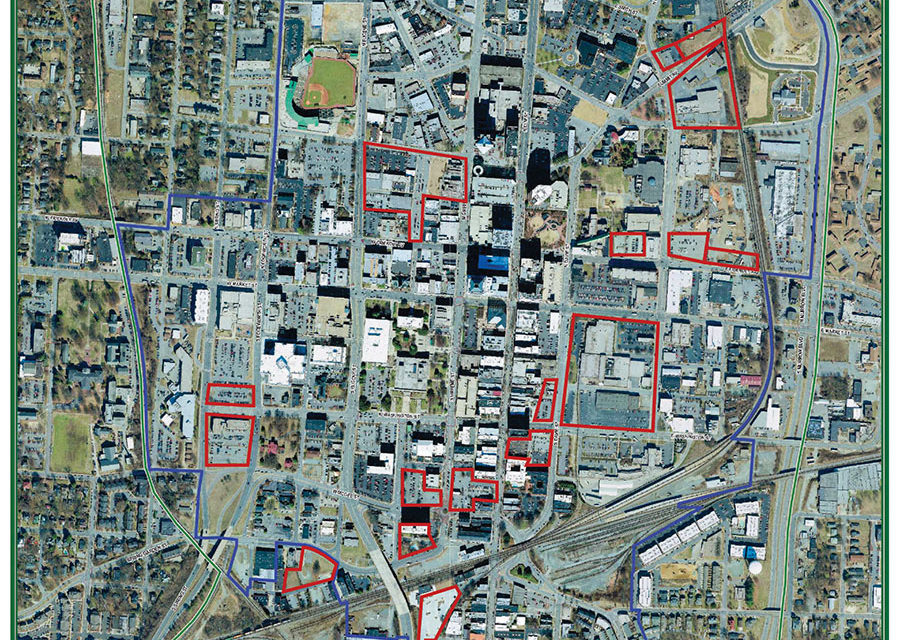Not long after former City Councilmember Zack Matheny took over as president of Downtown Greensboro Inc. (DGI) in the summer of 2015, I was in his office and he was showing me maps of the downtown.
He tends to flip through things pretty fast so you have to pay attention to keep up.
Zack was telling me that his plan was to get two new parking garages built in downtown Greensboro and pointing to possible locations on a map.
Then he said he was going to get developers to build the parking decks and in return the developers would have the air rights to build over them. The first floors of the parking decks would be retail, and over the parking decks would be 10 or maybe 20 stories of office, residential or whatever the developer wanted to build.
Then he said the words no journalist wants to hear: “But you can’t write about it.”
Zack said writing about it would kill the deals because there were a lot of moving parts.
Boy were there ever a lot of moving parts, but now, almost two years later, two parking decks are going to be built by developers in downtown Greensboro and then the developers are going to build over them.
The parking deck on East Market and South Davie streets will have a Westin hotel built over it that faces South Elm Street. Nobody is quite sure what Roy Carroll, who is the publisher of this newspaper, plans to build over the parking deck at the corner of Bellemeade and North Eugene streets, but part of it will reportedly be an Aloft hotel.
I thought Zack was being overly optimistic when he was talking about two parking decks with multi-story buildings over them, but it turns out he wasn’t. It took some time, and just one of the stumbling blocks was finding someone to buy the Dixie Building who would agree to keep the building but sell the parking lot.
Now Zack has turned to residential development in the downtown.
One big difference in the conversation I had with Zack this week is that I can write about it, and the other is that I’m convinced Zack will do it, where as before I had my doubts.
One of the issues Greensboro’s central business district has is that there aren’t enough people living downtown, but it’s not because people don’t want to – the vacancy rate in downtown residential property is only 4.7 percent. The problem is that there aren’t enough places for people to live.
I could go into a long diatribe here about how 20 years ago the city made it practically impossible to build residential downtown, but I won’t.
Downtown Greensboro currently has 2,683 residents, which is not bad compared to Durham with 2,500 and Winston-Salem with 2,982. But it is far behind Greenville, South Carolina, known for its renewed and vibrant downtown with 5,000 residents. And Charlotte is in a different world with 26,000 downtown residents.
But compared to our North Carolina neighbors of similar size, Greensboro is doing pretty well until you look at the numbers for downtown residences in development. Durham has 1,348 in development, Winston-Salem 1,283 and Greenville 2,293. Greensboro has 291 downtown residences in development – all of those are apartments at Carroll at Bellemeade.
Anyone who has followed residential development downtown knows that it takes a few years to get things rolling. It’s more difficult to build in a downtown area than it is to buy a field, have it rezoned and start popping up two-story apartment buildings.
In the downtown area development usually involves putting the property together and demolition before construction can begin. It took Carroll years to acquire the property for Carroll at Bellemeade; and then, for the project to go forward, the City of Greensboro had to agree to close a block of Lindsay Street.
All of the 291 residences at Carroll at Bellemeade will be apartments for rent, which means there is nothing currently under development in downtown Greensboro for people who want to buy rather than rent. Although I should probably mention that there are condominiums at Center Pointe, Zack says those are being grabbed up as quickly as they become available.
One of Zack’s efforts to help move along downtown residential development is to identify some suitable areas. The sites are outlined in red on the map (page 2).
So what Zack is working on now is finding developers who are interested in buying the properties and building apartments or condominiums.
Zack said that there were a lot of people who want to live downtown, but he added, “We’ve got to give these people a good place to live and we’re behind.”
There has been a 102 percent increase in the number of people living downtown since 2000. They tend to be well-educated, unmarried young adults. Only 3.6 percent of downtown residents are under the age of 14 while 27.5 percent are between 15 and 24, which is the largest age group. Next is 25 to 34 with 22.6 percent of the downtown population. The third largest group is those over 55, who make up 21.3 percent of downtown residents, while the 45 to 54 group only makes up 11.3 percent.
The median age of the downtown residents is 32.9. So along with a lot of young people living downtown you also have a sizable number of empty nesters who are selling their large suburban homes and moving downtown for the convenience.
Zack says it’s a chicken and egg situation – with more people downtown, the downtown will attract more amenities, and with more amenities the downtown will attract more residents. But he says the problem right now is that people want to move downtown but there aren’t enough places to live, and he plans to fix it.

